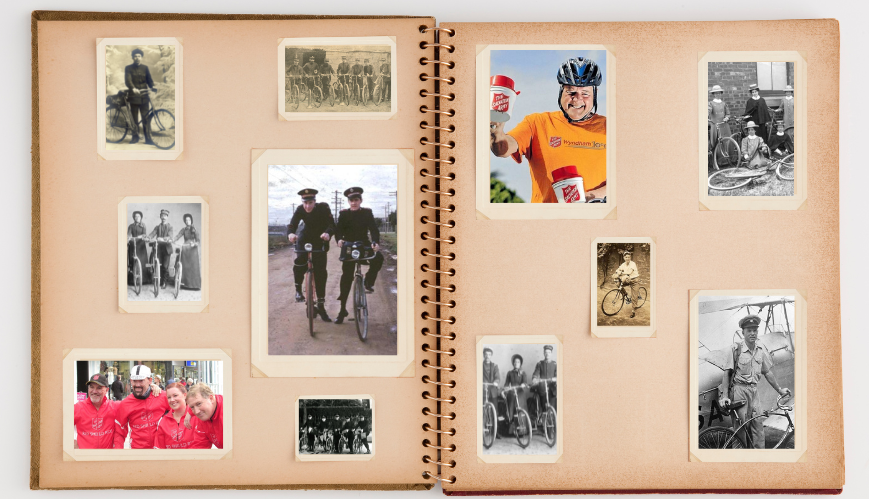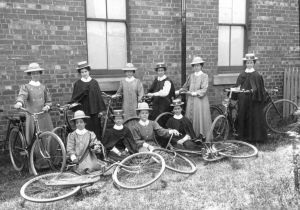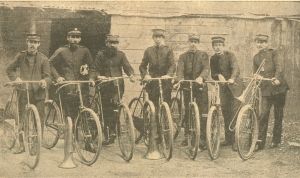Hurrah for the 'flying brigade of Salvation cyclists!'

Hurrah for the 'flying brigade of Salvation cyclists!'
The Salvation Army has always shared the gospel creatively – and delivering the Good News on a bike has been a mainstay since the late 1800s.
Some 125 years ago, The Victory, a Salvation Army periodical produced in Melbourne, promoted Commandant Herbert Booth’s decision “to utilise the bicycle for corps work”.
Noting the cost of feeding and keeping a ‘camp horse’, not to mention avoiding tram and train fares, the 1897 article described the remarkable adaptability of “a flying brigade of Salvation cyclists”.
 Samaritan nurses pose with their bicycles outside the Samaritan Nurses Home in Hotham St, East Melbourne.
Samaritan nurses pose with their bicycles outside the Samaritan Nurses Home in Hotham St, East Melbourne.
Salvationists pedalling merrily away were able to keep remote corps and outposts alive, conduct nursing and undertake evangelical and social work, including ‘rescue work’ (helping girls exit prostitution) and prison-gate ministry.
Urged on by Commandant Booth, the Army’s leader in Australia at that time, these Salvationists biked their way to play music and hold concerts and meetings. They sold vast numbers of The War Cry newspaper on their bicycles and rode around collecting for the Self Denial Appeal.
A bike had become “well-nigh indispensable”. The Salvos were selling ‘the Scarlet Runner’ safety bicycle, and a special ‘bicycle fund’ was set up to subsidise “poor corps requiring bicycles”.
The Victory also defended the honour, virtue and dignity of female Salvationists who chose to straddle a ‘pushie’, declaring that it was difficult “to grasp the justice of the prudish sentiment which, while conceding [a bike’s] usefulness so far as our male officers are concerned, would debar our women folk from similar facilities of locomotion,” it said.
“Mrs Colonel Bailey, Mrs Major Gilmour and Staff-Captain Paul were the first of our women officers to take to cycling [and] they boldly [did so to] pave the way for their sisters in the field.”
 A ‘bicycle band’ in 1898. The trombonist is George Carpenter, the future General of The Salvation Army.
A ‘bicycle band’ in 1898. The trombonist is George Carpenter, the future General of The Salvation Army.
That being said, whether on foot or on bike, Salvationists were not always greeted warmly. The Victory reported on the vitriol Salvationists faced by cyclists on the streets of Prahran: “A new offence was laid to the charge of The Salvation Army by Mr Chas. Salter, manager of the Royal Insurance Company, in the latest of his periodical complaints to the Prahran city council against the ‘army’. Mr Salter objected to the Army parading the streets; with discordant drums, tambourines and brass instruments and other vehicles of distraction, in a manner of a cross between an itinerant circus and ... minstrels, to the danger of life by frightening horses and bicycles, to the great depreciation of property.”
Despite this, the bicycles kept rolling along, brass bands notwithstanding, as did the Army. And The Victory declared: “The complaint met with no better fate than its predecessors. It was ‘received’, which, being interpreted, means that the army band will continue to frighten the bicycles that come within its range without let or hindrance from the Prahran city council.”
.jpg&width=300&height=324) Two Salvation Army officers on their rounds in the 1950s.
Two Salvation Army officers on their rounds in the 1950s.
Female Salvationists from the Samaritan Nurses’ Home at 111 Hotham Street, East Melbourne, rode near and far to offer comfort and assistance. Intrepid Salvationists slung instruments on their backs and pedalled thousands of miles over goodly decades. And the ‘League of Salvation Wheelmen’, aka the Scorchers (12 cyclists led by Colonel Peart), shared the good news about Jesus from their bicycle seats.
Envoy Fred Giles cycled around the world, and was the first man to cross Lapland on a bicycle, once getting ‘put off a tram in Russia for whistling’. And future Salvation Army General George Carpenter pushed his bike from open-air meetings to the hall, balancing a trombone all the while. Closer to home, flying padre Major Vic Pedersen pushed his folding bicycle (or paddled a canoe) in isolated areas of northern Australia where he couldn’t land his Tiger Moth.
Today, the tradition continues. Every year, Salvationist Les Porter from Wyndham Corps participates in the Wyndham 1000 to raise funds for the Salvos. And in previous years, Captain JohnMark Snead of Hobart Corps has ridden more than 650km across Tasmania for the Red Shield Appeal. His brother-in-law, Aaron Peterson, has also cycled to raise funds for the Red Shield Appeal, and in 2013 the Noble Park Salvationists cycled from Adelaide to Melbourne over five days. He continued the tradition of his grandfather, Major William ‘Dick’ Guy, the original Red Shield Rider who made the trek from Melbourne to Adelaide in 1940 and received his call to officership along the way.
What other modern-day Salvationists do you know who still ride to share the good news of the gospel? As the article in The Victory declared: “God bless our salvation cyclists! Hurrah for the cycle war!”
For more stories, photos and information on Salvation Army history in Australia, go to facebook.com/SalvosMuseums
Comments
No comments yet - be the first.